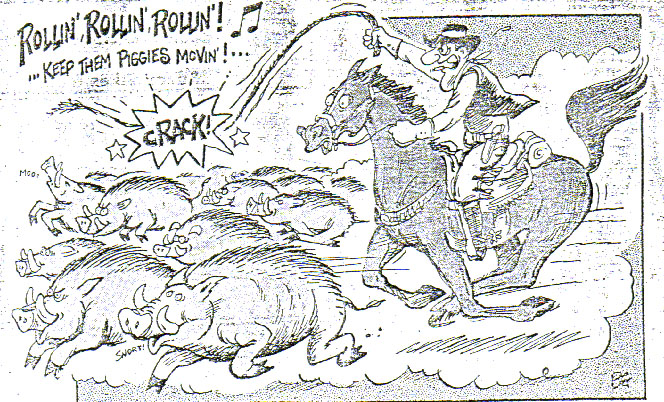SAN
ANGELO STANDARD December 13,
1982
Out
Yonder -- Ross
McSwain
Tales
recreate hard,awkward hogherding days

MASON -- The
late John Martin, who ranched in the Mason country many years ago,
helped accomplish a nearly impossible mission in February 1896 when he
and eight or nine others successfully drove about 400 head of fat hogs
to market from the Streeter community in Mason County to San Angelo, a
distance of about 125 miles.
Anybody who has ever been around hogs knows
they are not the easiest animals to direct around in a pen, much less
across about 125 miles of unsettled open rangeland where water holes
are scarce and there are ample draws and creekbeds to lure the pesky
porkers to stop and root around.
Martin's story of the 17-day-long hog drive
came to light recently during a search through Standard-Times files.
According to Martin, the year 1895 had been a
prosperous one for Mason County farmers. Corn cribs were full to
overflowing and hundreds of bushels of corn had been left in the fields.
Martin related that his father, Dan Martin,
decided he could make some extra money fattening out a bunch of hogs.
He also was a cattle trader with plenty of
pen space
for the porkers. The Martins found their hogs -- about 400 head of
small, razorback types -- in neighboring Menard County.
The hogs' journey to market actually started
the day the Martins bought them from Mann. The Martins drove the
porkers about 30 miles from the Mann Ranch to their own place near
Streeter.
2
"We had a bit of trouble getting them to the
ranch," Martin recalled in his story. "They stampeded two or three
times, and at one time it seemed we had hogs scattered all over Menard
County," he said.
When time came to sell the hogs, the Martins
decided to drive them to San Angelo where they felt they could get a
good price. The trip would be about 125 miles by trail.
Martin said about 125 bushels of corn were
purchased to feed the hogs on the drive. It took two wagons to carry
the corn.
The drover party included Martin, his father,
Dan Martin, an uncle, Tom Martin, a black man named Bob, John Teague
and about three others.
"Uncle Tom was our morale builder, telling
jokes; John Teague was our singer;
and Bob
was the brunt of everything," Martin said.
Martin said the hogs were fat and had to be
driven slowly. His job was to saddle the only riding horse the group
had each morning and ride around the hogs a couple of times to get them
started. He also looked for strays.
The trail led to Menard, then up to the
Kickapoo Creek.
One night while camped along the Kickapoo,the
hogs were disturbed by loud howling and the bleat of a small calf being
attacked by wolves, a common occurrence in those days.
"We'd find several carcasses each day of
calves that had been killed by the wolves the night before," Martin
said.
According to Martin, the country close to the
Kickapoo was "a prairie section of low hills and tall grass. There were
no trees and the hog drivers ran out of firewood. They had to cook and
keep warm on fires made by soaking cow chips in kerosene.
page 2
On the
16th day, a dark cloud came up in the northwest when the men and hogs
were about
five miles away from San Angelo on the Lipan Flat. The men found a
sheltered
place for the hogs and tried to bed them down before the cloud struck.
"The rain froze as it fell. The next morning
was a dreary scene. It was awful -- cold and mud -- driving the hogs
those last five miles," Martin said.
The hogs were penned in San Angelo the evening
of the 17th day, and Martin's father made the rounds to butcher shops
looking for buyers. He finally sold the hogs to three butchers for 3
1/2 cents a pound.
"Part of it was paid in cash, with the
remainder to be paid in a few days. I never knew if we got paid all of
it or not," Martin said.
article
transcribed & picture scanned by Carol Martin